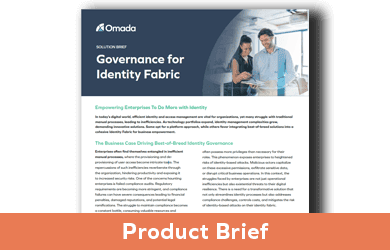Most organizations look at Identity Governance and Administration (IGA) the way people look at officials in a sports match. When the quality of the officiating is good, they hardly notice it. When the officiating is bad, it becomes the principal focus of the match. Just like with officiating at a sports event, simply having an IGA solution in place is no guarantee that it will be sufficient to do the job properly. Many organizations have created a false sense of security when it comes to their IGA solutions. As organizations evolve, security threats become more complex and more difficult to manage. Identity governance practices that have been effective in the past may not be today. There is never a bad time for an organization to take an objective look at its IGA solution to ensure it delivers the functionality required to secure identities and ensure appropriate levels of access to data and applications.
In this post, we offer a data-driven checklist of issues you need to address in your organization to ensure your IGA solution lives up to its role in securing IT assets across your entire environment.
1. A legacy IGA solution is costly and exposes unnecessary risk
According to findings from The State of Identity Governance 2024, IT professionals using legacy or in-house-built IGA report significantly greater concern about identity-related threats. The data suggests that “IGA vintage matters.” In general, as your solution ages the more costly it is to maintain; and TCO increases over time. This cost increase is largely due to the number of customizations that organizations must build to meet new requirements and the difficulty of maintaining a legacy system over time. Software patches, the continued development support needed to integrate every new system, and the programming required to add new workflows to the solution all contribute to these costs. It is frequently just as difficult and costly to update and customize the IGA functionality provided by a single vendor IAM platform, making a configurable best-of-breed IGA solution a more financially sound choice.
2. Eliminate over-permissioned users with unnecessary access to systems and applications
The State of Identity Governance 2024 reports more than seven in ten IT professionals agree that people in their organizations have unnecessary access to assets or have excessive permissions. Unnecessary access to systems and applications is a principal cause of identity security breaches, compromised user accounts, and hackers gaining unauthorized access to sensitive data. Strong identity verification, quickly identifying and suspending suspect accounts, and producing reports that show compliance only work to mitigate identity-related risks if an organization knows that every user has the right access to do their jobs. You need a modern IGA to manage identity lifecycles, access requests, provisioning, changing roles and policies, and security breach response in real time if you want to stop over-permissioned accounts and unnecessary access. This is also the principal requirement for implementing a mature zero-trust security model.
3. Ensure your IGA tools deliver the functionality to create a zero-trust security model
IT organizations using legacy or in-house-built IGA are more concerned about identity-related threats than adopters of modern IGA solutions. Modern IGA tools are far more effective at stopping risky practices like providing unnecessary access to systems and not removing excess permissions from accounts. Most organizations have more identities working remotely and legacy and in-house-built IGA struggle to manage these identities effectively. Even in organizations that have implemented modern IGA to work in all environments, the data suggests that they may not be properly deployed using a best practices process framework. If you use a legacy IGA today, you should evaluate modern IGA solutions with best practices frameworks and build a migration plan. If you have migrated to a modern IGA solution, you must ensure you are deploying it in a way that optimizes functionality.
4. Your IGA approach must be able to prove who has access and who actually should have access
You must be able to demonstrate that your identity governance strategy is effective, even as your organization onboards new identities and applications. A modern IGA solution makes generating accurate compliance reporting more efficient. As your business processes become more complex, your IGA solution must enable you to determine who has access to data and applications and who shouldn’t have access to it. It is vitally important that you can prove this at any point. Having the ability to show that just the users that should have access, have just the required level of access, and have no additional level of access, at any point in time, is critical for any compliance audit. Finally, having the ability to ensure consistent, repeatable reporting is as important.
5. Choose an individual best-in-breed IGA solution over a single IAM platform that offers IGA
Data shows about 80 percent of organizations using modern IGA are more likely to choose individual IAM solutions (e.g., IGA, PAM, CIEM, DAG, ITDR, etc.) offering superior functionality than a single product that offers many IAM solutions. While “one-stop shopping” like this may be less costly at the outset, there are disadvantages. First, it ties your organization to a single vendor and makes it difficult and expensive to change. Second, it makes adding outside systems that could improve IAM more difficult. Finally, it forces your organization to live with some inferior technology that may affect IAM performance overall and increase identity-related risks.
6. Value adaptability more than anything else
Adaptability is a priority because when you choose individual IGA solutions that offer best-in-breed functionality, it must be configurable to other systems and applications to meet your organization’s specific requirements. When evaluating a new solution, most business leaders and IT professionals look for a connectivity framework that enables their organization to apply real-time IGA to their assets without costly customization. Governance for Identity Fabric provides the configurability, connectivity, and adaptability to work seamlessly with an organization’s existing applications and infrastructures and other IAM solutions. It also enables interoperability with support capabilities like generative AI that help automate real-time identity and access management. SaaS-based Governance for Fabric provides faster data ingestion and the capacity to synch quickly to onboard applications and enables users to optimize business processes constantly. Governance for Identity Fabric provides centralized management and governance support in decentralized environments with multiple access points while maintaining control requirements and performance levels.
As you address these points in your organization, you will get a clearer picture of where you are on the journey to securing identities and assets and creating a mature, sustainable zero-trust security model. Starting with a modern IGA solution in the context of Governance for Identity Fabric enables you to fast-track your efforts in a way that mitigates identity-related cybersecurity risks and puts your IT teams more at ease with your organization’s ability to do the job.

























